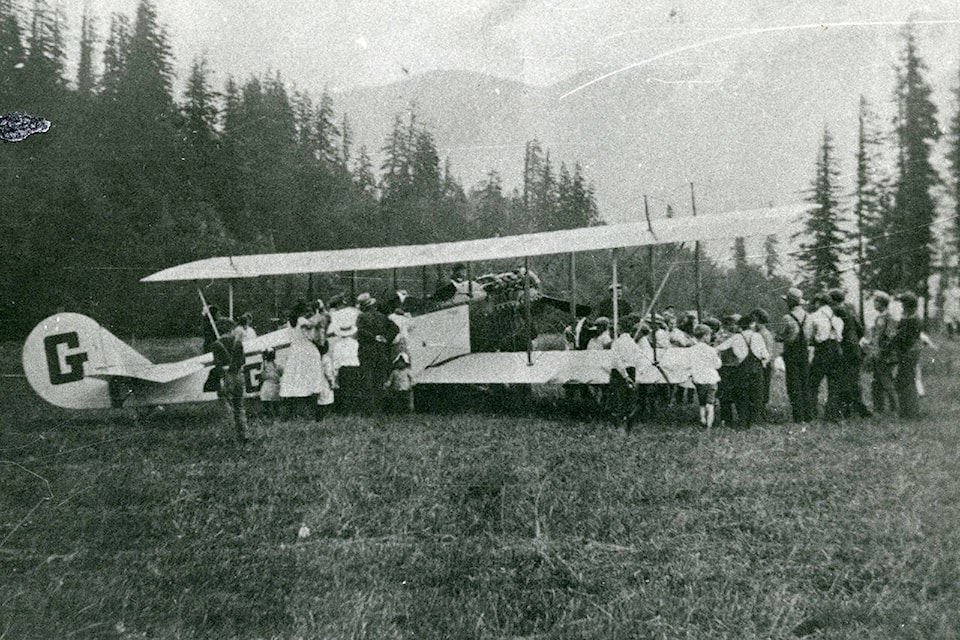By Lindsay Foreman
Over the last couple of weeks I have been researching past modes of transportation to and in the Agassiz-Harrison Valley. To my surprise, we have several different photographs of planes in our archives.
Planes? Yes, my thoughts exactly. Despite not having an airport, a number of different pilots have landed in our valley and on Harrison Lake over the past century.
Our society initially shared its musings on local aircraft encounters in the Oct. 26 and Nov. 23, 1988 editions of The Agassiz Advance. These articles included a discussion of the Peggy, the first known plane to land in Agassiz at the Dominion Experimental Farm (today the Agassiz Research and Development Centre) in 1919.
The Peggy was a Curtiss JN-4 “Jenny,” registered as C-CAAG, built in 1917 by Canadian Aeroplanes & Motors Ltd., Toronto. Also known as a “Canuck,” this plane served with the Royal Flying Corps and was used in Ontario to train beginning Canadian pilots to support the British Royal Flying Corps between 1917 and 1919. It’s estimated that approximately 95 per cent of all First World War pilot trainees flew a “Jenny” or “Canuck”; these were twin-seat (student in front of instructor) dual-control biplanes.
RELATED: Canadians mark Remembrance Day, 100 years since end of First World War
The Peggy was purchased in April 1920 by Pacific Aviation Co. of Vancouver, and subsequently sold to Vancouver’s J. Scott Williams in August 1921. The aircraft was struck off register in April 1924; we are uncertain of its final fate.
An item of interest: the 1919 landing of the Peggy in Agassiz occurred only 10 years after the first flight in Canada, taken by Douglas McCurdy in the Silver Dart, from Cape Breton, N.S. on Feb. 23, 1909, and approximately 16 years after the Wright Brothers flew their Flyer in North Carolina in 1903.
Flying caught on quickly, partly because it didn’t require the development of associated infrastructure, as did transportation by rail or automobile.
As early as 1910, engineers were working to develop amphibious aircraft that could take off and land on water. By the late 1930s, seaplanes were among the largest and fastest aircraft in the world, and soon became affordable and available for purchase by small companies and even individuals.
| A float plane docked at the old beach in Harrison Hot Springs, circa 1950s. (Agassiz-Harrison Historical Society) |
One photo, taken in the 1950s, illustrates a float plane docked at the old beach on Harrison Lake, although we don’t know who it belonged to or what it was used for. Was it flown in by a guest to our community, or was it owned by a local business and used for search and rescue missions or for tours? If you have any information about float planes on Harrison Lake we would love to hear from you.
I recall some of my lazy summer days in central Ontario, loafing on the dock at the cottage only to be disturbed by the familiar sound of a plane. One of the nearby cottage owners regularly arrived via float plane, and we were envious — especially after five to six long hours fighting traffic, and then a short boat ride over to our cottage.
Float planes certainly are convenient but still a luxury for most.
| Two children standing by a plane in an Agassiz field, circa 1960s. (Agassiz-Harrison Historical Society) |
In our archives, we also have photographs of a small aircraft landing and taking off from an Agassiz field sometime in the 1960s. We don’t have any information on who piloted this plane, from where and to whom they were visiting. But we do have this snapshot of two lucky children who got “up close” with the craft – perhaps they even got a ride.
Interested in further information about these planes or other forms of transportation? During Heritage Week you will be able to preview our refreshed exhibit on transportation and travel in the Agassiz-Harrison Valley. We will be open from 10 a.m. until 4 p.m. on Monday, Feb. 18 to celebrate Family Day. We will also host a Family History Q-and-A on Wednesday, Feb. 20 from 7 to 9 p.m. and a Heritage Speaker’s Night on Friday, Feb. 22 from 7 to 9 p.m.
What are your aircraft memories in the Agassiz-Harrison Valley? We would love to hear about your experiences. Please contact us at agassizharrisonmuseum@shawbiz.ca or 604-796-3545.
news@ahobserver.com
Like us on Facebook and follow us on Twitter
